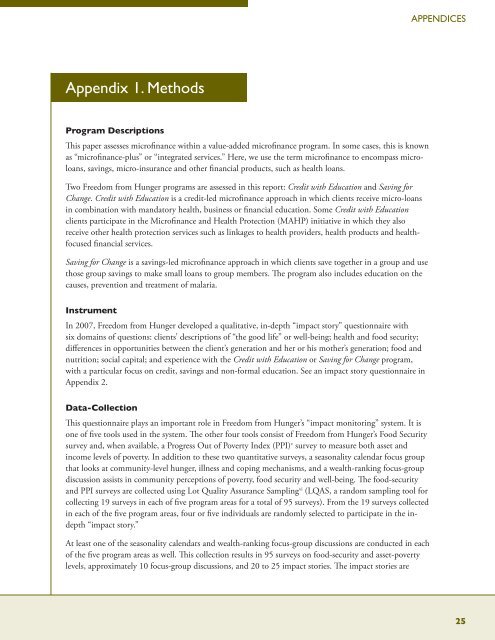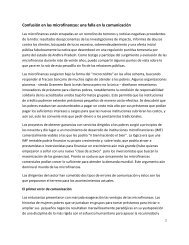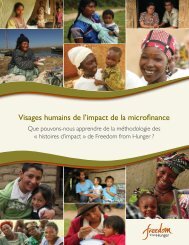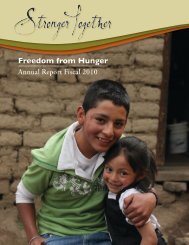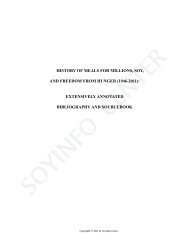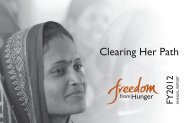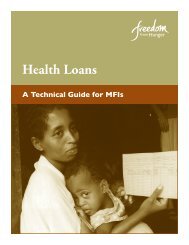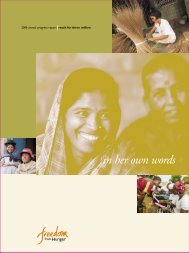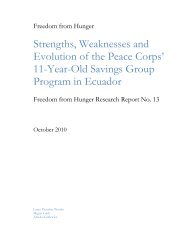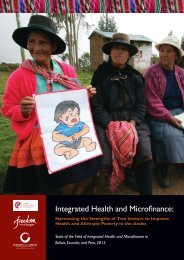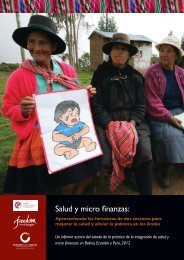English - Freedom from Hunger
English - Freedom from Hunger
English - Freedom from Hunger
You also want an ePaper? Increase the reach of your titles
YUMPU automatically turns print PDFs into web optimized ePapers that Google loves.
appendix 1. Methods<br />
Program Descriptions<br />
This paper assesses microfinance within a value-added microfinance program. In some cases, this is known<br />
as “microfinance-plus” or “integrated services.” Here, we use the term microfinance to encompass microloans,<br />
savings, micro-insurance and other financial products, such as health loans.<br />
Two <strong>Freedom</strong> <strong>from</strong> <strong>Hunger</strong> programs are assessed in this report: Credit with Education and Saving for<br />
Change. Credit with Education is a credit-led microfinance approach in which clients receive micro-loans<br />
in combination with mandatory health, business or financial education. Some Credit with Education<br />
clients participate in the Microfinance and Health Protection (MAHP) initiative in which they also<br />
receive other health protection services such as linkages to health providers, health products and healthfocused<br />
financial services.<br />
Saving for Change is a savings-led microfinance approach in which clients save together in a group and use<br />
those group savings to make small loans to group members. The program also includes education on the<br />
causes, prevention and treatment of malaria.<br />
Instrument<br />
In 2007, <strong>Freedom</strong> <strong>from</strong> <strong>Hunger</strong> developed a qualitative, in-depth “impact story” questionnaire with<br />
six domains of questions: clients’ descriptions of “the good life” or well-being; health and food security;<br />
differences in opportunities between the client’s generation and her or his mother’s generation; food and<br />
nutrition; social capital; and experience with the Credit with Education or Saving for Change program,<br />
with a particular focus on credit, savings and non-formal education. See an impact story questionnaire in<br />
Appendix 2.<br />
Data-Collection<br />
This questionnaire plays an important role in <strong>Freedom</strong> <strong>from</strong> <strong>Hunger</strong>’s “impact monitoring” system. It is<br />
one of five tools used in the system. The other four tools consist of <strong>Freedom</strong> <strong>from</strong> <strong>Hunger</strong>’s Food Security<br />
survey and, when available, a Progress Out of Poverty Index (PPI) v survey to measure both asset and<br />
income levels of poverty. In addition to these two quantitative surveys, a seasonality calendar focus group<br />
that looks at community-level hunger, illness and coping mechanisms, and a wealth-ranking focus-group<br />
discussion assists in community perceptions of poverty, food security and well-being. The food-security<br />
and PPI surveys are collected using Lot Quality Assurance Samplingvi (LQAS, a random sampling tool for<br />
collecting 19 surveys in each of five program areas for a total of 95 surveys). From the 19 surveys collected<br />
in each of the five program areas, four or five individuals are randomly selected to participate in the indepth<br />
“impact story.”<br />
At least one of the seasonality calendars and wealth-ranking focus-group discussions are conducted in each<br />
of the five program areas as well. This collection results in 95 surveys on food-security and asset-poverty<br />
levels, approximately 10 focus-group discussions, and 20 to 25 impact stories. The impact stories are<br />
aPPendICes<br />
25


